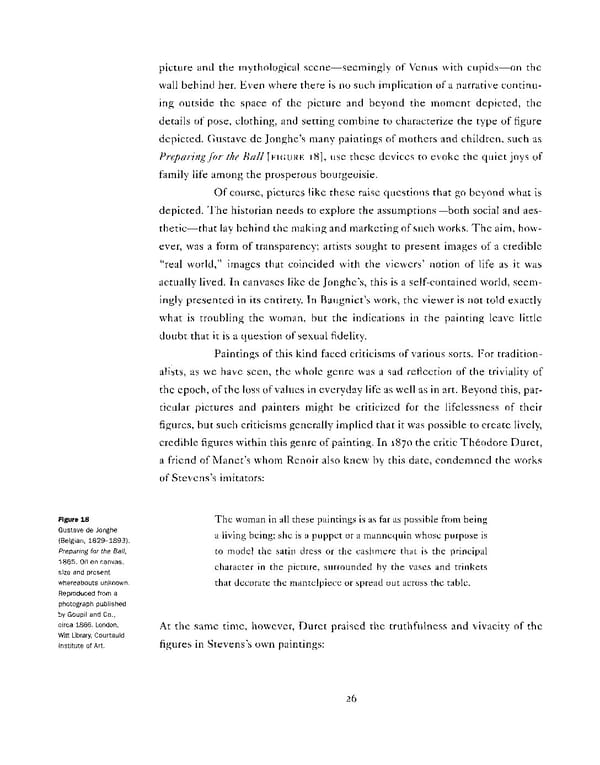picture and the mythological scene—seemingly of Venus with cupids—on the wall behind her. Even where there is no such implication of a narrative continu- ing outside the space of the picture and beyond the moment depicted, the details of pose, clothing, and setting combine to characterize the type of figure depicted. Gustave de Jonghe's many paintings of mothers and children, such as Preparing for the Ball [FIGURE 18], use these devices to evoke the quiet joys of family life among the prosperous bourgeoisie. Of course, pictures like these raise questions that go beyond what is depicted. The historian needs to explore the assumptions—both social and aes- thetic—that lay behind the making and marketing of such works. The aim, how- ever, was a form of transparency; artists sought to present images of a credible "real world," images that coincided with the viewers' notion of life as it was actually lived. In canvases like de Jonghe's, this is a self-contained world, seem- ingly presented in its entirety. In Baugniet's work, the viewer is not told exactly what is troubling the woman, but the indications in the painting leave little doubt that it is a question of sexual fidelity. Paintings of this kind faced criticisms of various sorts. For tradition- alists, as we have seen, the whole genre was a sad reflection of the triviality of the epoch, of the loss of values in everyday life as well as in art. Beyond this, par- ticular pictures and painters might be criticized for the lifelessness of their figures, but such criticisms generally implied that it was possible to create lively, credible figures within this genre of painting. In 1870 the critic Theodore Duret, a friend of Manet's whom Renoir also knew by this date, condemned the works of Stevens's imitators: Figure 18 The woman in all these paintings is as far as possible from being Gustave de Jonghe a living being; she is a puppet or a mannequin whose purpose is (Belgian, 1829-1893). Preparing for the Ball, to model the satin dress or the cashmere that is the principal 1865. Oil on canvas, character in the picture, surrounded by the vases and trinkets size and present whereabouts unknown. that decorate the mantelpiece or spread out across the table. Reproduced from a photograph published by Goupil and Co., circa 1866. London, At the same time, however, Duret praised the truthfulness and vivacity of the Witt Library, Courtauld figures in Stevens's own paintings: Institute of Art. 26
 Pierre-Auguste Renoir: La Promenade Page 33 Page 35
Pierre-Auguste Renoir: La Promenade Page 33 Page 35